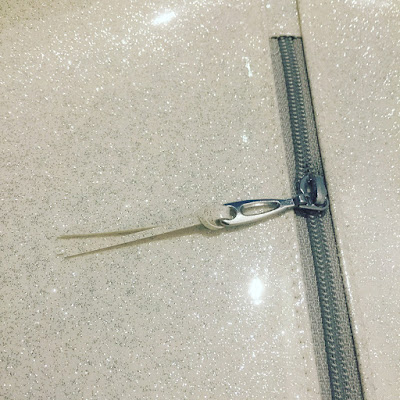Cutting Instructions:
4 ✂ 1/2" x 4 3/4" of your heavy fusible interfacing.
2 ✂ 1" x 5 1/2" of your exterior fabric.
1. For the female part of the frame (with the opening), take two of your heavy interfacing pieces, in the middle of each, cut away a 5/8" x 1/4" big rectangle like in the photo . Fuse them centered to one of your fabric pieces like in the photo with a small, scant 1/8" opening between the two in the middle to allow for folding.
2. Make 1/4" long cuts in the fabric next to your heavy interfacing in the middle to allow you to fold up the fabric around the interfacing like in the photo, glue in place.
5. Insert into the frame and screw in place. The padding will extend slightly below the frame to allow for a softer grip.
6. For the your male part of the frame, just place your interfacing without cutting out the middle like in step 1. Skip step 2 and just fold in the short fabric ends over the interfacing and glue in place like in step 3.
7. Fold the whole piece in half lengthwise to get the result in the photo. Cut out a little section in the middle to make room for the lock (no need to make the fancier covered openings here as it'll never be seen anyway). Insert and screw in place.
2. Make 1/4" long cuts in the fabric next to your heavy interfacing in the middle to allow you to fold up the fabric around the interfacing like in the photo, glue in place.
3. Fold up the short ends of your fabric over your interfacing and glue in place.
4. Fold in half lengthwise and insert into your frame. The little fold we made will allow the lock to be inserted without seeing any raw interfacing.
6. For the your male part of the frame, just place your interfacing without cutting out the middle like in step 1. Skip step 2 and just fold in the short fabric ends over the interfacing and glue in place like in step 3.
7. Fold the whole piece in half lengthwise to get the result in the photo. Cut out a little section in the middle to make room for the lock (no need to make the fancier covered openings here as it'll never be seen anyway). Insert and screw in place.
~~~~~~~~ ♥ ~~~~~~~~ ♥ ~~~~~~~~
♥ Thanks a lot Pia for sharing this with us, it's much appreciated!! ♥
















































